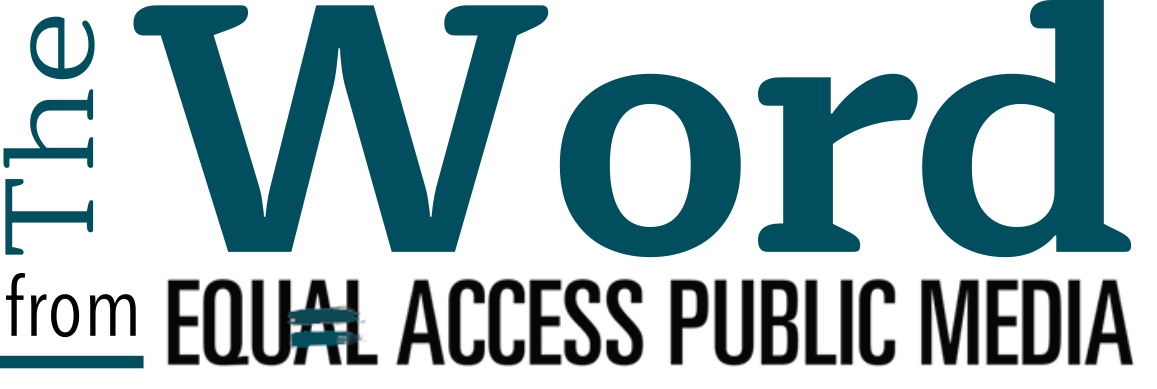Deafblind activists discuss educational funding cuts
When news broke that the Dept. of Ed was halting grants, deafblind voices were left out of the conversation
The U.S. Department of Education cut funding for services for deafblind students in eight states in September. The public outcry was loud, especially from people who are deafblind.
But in news articles after the initial cuts, there was silence from people who are deafblind. News stories largely left out statements from people who are deafblind, while instead quoting sighted and hearing educators and parents.
According to the National Center on Deafblindness, approximately 10,000 children and youth who are deafblind live in the United States. While there is no definitive census, most recent estimates suggest about 40,000 deafblind individuals, including both children and adults, live in the United States. But the National Center on Deafblindness suggests it is working to improve identification for a more accurate number.
This undercounting compounds another systemic issue: Many organizations serving the deafblind community are led by individuals who are not deafblind themselves,
said Morrison, a consultant and director for the state of Connecticut’s Aging and Disability Services Bureau. They go by one name, and they are deafblind.
As the federal funding turned off, a lifeline came through: the National Center on Deafblindness announced it would provide individual grants to the educational centers harmed by the cuts. Still, the news articles quoted mostly sighted and hearing educators and parents.
When leadership lacks lived experience, decisions often fail to reflect the real needs of the community. This disconnect can result in harmful policies, misallocated resources, and, in this case, the termination of vital services — which is also inhumane,
Morrison said. These cuts are not just administrative oversights. They are a reflection of a broader failure to center deafblind voices and presence in decisions that directly affect their lives.
In early September, the Department of Education sent letters to three states and a regional consortium for children and young adults in the Deafblind community announcing it would end federal funding by Sept 30. Those states included Oregon, Washington, Wisconsin, as well as the New England Consortium on Deafblindness, which includes Connecticut, Maine, Massachusetts, New Hampshire, and Vermont.
More than $30 million in grants funded under rules of the Individuals with Disabilities Act through the Department of Education (IDEA) were also cut at the beginning of September.
Cuts to federal funding also affected the Protactile Language Interpreting, education programs for adults, American Sign Language education, and other programs.
The Department of Education, which oversees this funding, made the cuts in a nod to Donald Trump’s Jan. 20 Executive Order titled Ending Radical And Wasteful Government DEI Programs And Preferencing,
which noted these services are prejudiced and are forced illegal and immoral discrimination programs, going by the name of
or DEI.diversity, equity and inclusion,
But many people disagree with that assessment — especially those who use these services or whose lives are affected by the cuts.
These cuts are not just administrative; they are an injustice against one of the most marginalized groups in our society,
Morrison said. Deafblind individuals deserve access, dignity, and opportunity. We must fight to restore these grants and protect the rights of every deafblind student.
In early October, the National Center on Deafblindness announced it would provide subgrants to the Wisconsin, Oregon, Washington, and New England deafblind program from a government supplemental grant. A supplemental grant is a type of grant funding that boosts specific programs, services, or needs.
I am deeply grateful to the families, educators, and advocates who raised their voices and shared their powerful stories,
State Superintendent Dr. Jill Underly said in a press release after the Wisconsin Deafblind Technical Assistance Project secured funding from the National Center on Deafblindness. Because of their courage and persistence, the importance of the WDBTAP came into focus — and helped protect an essential lifeline for children and families across Wisconsin.
Although outlets including ProPublica and Education Week noted that the funds canceled in September were rerouted to the National Center on Deafblindness, The Word was unable to confirm the National Center on Deafblindess’s supplemental grant was, in fact, new or from the previously canceled funds.
After consulting internally, I’m afraid we’re not able to provide additional clarification on this matter at this time,
said a spokesperson for Helen Keller Services when asked if the supplemental grant was new, from funds rerouted from the recently canceled grants to the state-level programs, or from a previous supplemental grant to Helen Keller Services for the National Center on Deafblindness.
The subgrants are bridging an important gap.
As humans, we rely on our sight and hearing for many things. When those are impacted, it makes life much harder,
Adrian Klenz said, who runs The Center Deaf-Blind Persons in Wisconsin. That is why programs like this are so important. They help teach people dealing with dual sensory loss learn how to adapt and navigate life. This is especially important with kids. You want to start helping them at a young age.
Marc Safman is an attorney working for deafblind people. He agrees, but also adds that students are impressive. Most of them are working hard and striving to overcome every obstacle. Safman is also deafblind. Many people don’t completely understand the struggle because they have either sight or hearing or both, he said.
People who are deafblind are more vulnerable because of the communication and mobility challenges of combined vision and hearing differences,
he said. The innovation and collaboration within these programs and the National Center on Deafblindness are amazing. You have to work with the student’s residual vision and hearing to figure out solutions. Frequently the kids have additional challenges. Most states lack basic co-navigator/support service provider, or communication facilitator programs.
A co-navigator or support service provider is a person who is trained to work one-on-one to help a person with support needs.
Safman is leading the way in creating state co-navigator programs for people who are deafblind.
New York has the largest population of deafblind people, but there is no support in New York state,
he said. Very limited. You have to know to file a case with the (New York State Commission for the Blind). Even then you get limited support. None really beneficial to me.
It’s why he’s working to build support for people who are deafblind, like in his home state of New York where he helped form the New York State Coalition of Deaf, DeafBlind, and Hard of Hearing Legislative Advocates. So far, programs have been founded in 18 states.
Still, for conversation, Safman relies on technology, not a co-navigotor or support service provider. He uses Live Transcribe for one-to-one talking and InnoCaption for phone calls.
While some apps (such as Live Transcribe, Supersense) offer limited support, they cannot replace trained human interpreters, co-navigators or educators skilled in tactile communication,
Morrison said. These technologies are tools — not solutions.
Morrison added that deafblind education and services are more than just deaf and blind services added together.
Deafblind is not simply the sum of
they said. deafness and blindness,
It is a distinct disability requiring specialized support. IDEA explicitly states that students who are deafblind cannot be served adequately in programs designed solely for the deaf or blind.
Some of these people are highly specialized who know Protactile, a tactile language practiced by people who are deafblind that relies on touch on the body; Braille; technical assistance; and may be consultants who are deafblind themselves.
Without these services, deafblind students face profound barriers to education, communication and independence,
Morrison said. These cuts are not just budgetary; they are a denial of access and a violation of civil rights.
Jodi Miskell is designer, copy editor, and writer. She cares about accessibility, disability, and the style guide.
This is news. This article uses interviews with experts and people whose experiences are relevant to a topic along with facts to tell a story about an issue.
Want more of the Word?
Become a Word Patron
Love what you’re reading? Want a to read more? Become a Patron and support The Word for as little as $2.99 a month.

